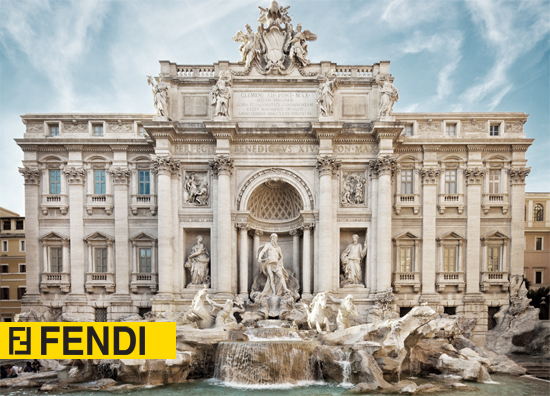Cross-Sector Partnerships in the Arts: Fendi and the Trevi Fountain
At a press conference on Monday, Fendi designers announced the fashion house will finance the restoration of two fountains in Rome, the  Quattro Fontane and the iconic Fontana di Trevi, or Trevi Fountain (built between 1732 and 1762). The US$2.9 million (€2.18 million), 20-month project will be completed in phases, as explained by Fendi designers Karl Lagerfeld and Silvia Venturini Fendi. These phases will include the re-waterproofing of the main basin, the cleaning of the façade and marble statues, and restoration of the gilded inscriptions. The Trevi Fountain will remain open to tourists throughout the restoration process (fear not tourists, fear not).
This announcement comes at a time when the funding for and preservation of cultural heritage sites in Italy is uncertain. Fendi, however, is not the first big-brand fashion name to take action in the preservation of Italy’s cultural heritage. Tod’s, an Italian company producing leather shoes and bags, is currently financing the restoration of the Coliseum for US$34 million (€25 million). Further north in Venice, Diesel, an Italian fashion company, is funding the restoration of the Rialto Bridge for US$6.7 million (€5 million).
Quattro Fontane and the iconic Fontana di Trevi, or Trevi Fountain (built between 1732 and 1762). The US$2.9 million (€2.18 million), 20-month project will be completed in phases, as explained by Fendi designers Karl Lagerfeld and Silvia Venturini Fendi. These phases will include the re-waterproofing of the main basin, the cleaning of the façade and marble statues, and restoration of the gilded inscriptions. The Trevi Fountain will remain open to tourists throughout the restoration process (fear not tourists, fear not).
This announcement comes at a time when the funding for and preservation of cultural heritage sites in Italy is uncertain. Fendi, however, is not the first big-brand fashion name to take action in the preservation of Italy’s cultural heritage. Tod’s, an Italian company producing leather shoes and bags, is currently financing the restoration of the Coliseum for US$34 million (€25 million). Further north in Venice, Diesel, an Italian fashion company, is funding the restoration of the Rialto Bridge for US$6.7 million (€5 million).
Of course, these generous donations do not go without recognition. For Tod’s, the funding agreement provides the company the rights to the Coliseum’s logo for 15 years, as well as branding Coliseum tickets with the company logo. Fendi’s sponsorship of Rome’s grandest fountain will be recognized by a small plaque to be placed near the fountain for four years.
The city council and Mayor Gianni Alemanno of Rome are hopeful these interventions will continue, as the preservation of the country’s past is in peril. Alemanno said, “Without similar initiatives, we won’t be able to save the cultural memory of our country.” Though council members are supportive of the private sector’s involvement in the preservation of Italy’s cultural heritage, some conservators are wary. They fear private-public partnerships will commercialize monuments of national pride, turning sites of inherent meaning and cultural significance into fashion advertisements.
The private-public partnership between Fendi and the Trevi Fountain is just one of many examples of a paradigm shift in the cultural sector regarding what Alemanno says is, “a new system of cultural patronage.”